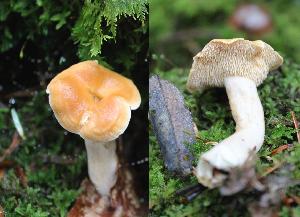
Within the framework of the CSP 'Metatranscriptomics of Forest Soil Ecosystems' and the 1000 Fungal Genomes (1KFG) project, we are aiming to explore the interaction of forest trees with communities of soil fungi, including ectomycorrhizal symbionts that dramatically affect tree growth, and saprotrophic soil fungi impacting carbon sequestration in forests. We are sequencing the genome of the most abundant fungal species harvested on studied long-term observatories to provide sufficient taxonomic coverage of fungal genomes to identify and analyze DNA and RNA samples sequenced from environmental samples.
The Terracotta Hedgehog
Hydnum rufescens Schaeff. is a popular edible
basidiomycete of the family Hydnaceae (Cantharellales). It is
sometime considered a variety of a commoner toothed mushroom, the
Hedgehog Mushroom, Hydnum repandum. H. rufescens
is an ectomycorrhizal symbiont of Norway spruce and other conifers,
occasionally with hardwoods; often forming rings or arcs among the
moss and leaf litter of the forest floor. The culture of the
isolate UP504 was obtained from fresh sporocarp material from
fruiting bodies collected under Pinus abies and P.
sylvestris in Uppsala (Sweden) by Dr. Andy Taylor. The genome
of H. rufescens will contribute to our understanding of
the biochemical and enzymatic properties of ectomycorrhizal fungi
and their role in terrestrial ecosystems and global carbon cycling.
The genome sequences of the orchid mycorrhizal fungus
Tulasnella calospora and the wood decayer
Botryobasidium botryosum are closely related sequenced
genomes that can be used in comparative genomics to identify
lifestyle-related gene repertoires in the Cantharellales.
The 'Metatranscriptomics of Forest Soil Ecosystems' and
the 1KFG projects are large collaborative efforts aiming for master
publication(s). As always, please contact the PI associated with
unpublished 1KFG genomes for permission prior to the use of any
data in publications. Contact for H. rufescens: Francis
Martin (INRA).
Genome Reference(s)
Miyauchi S, Kiss E, Kuo A, Drula E, Kohler A, Sánchez-García M, Morin E, Andreopoulos B, Barry KW, Bonito G, Buée M, Carver A, Chen C, Cichocki N, Clum A, Culley D, Crous PW, Fauchery L, Girlanda M, Hayes RD, Kéri Z, LaButti K, Lipzen A, Lombard V, Magnuson J, Maillard F, Murat C, Nolan M, Ohm RA, Pangilinan J, Pereira MF, Perotto S, Peter M, Pfister S, Riley R, Sitrit Y, Stielow JB, Szöllősi G, Žifčáková L, Štursová M, Spatafora JW, Tedersoo L, Vaario LM, Yamada A, Yan M, Wang P, Xu J, Bruns T, Baldrian P, Vilgalys R, Dunand C, Henrissat B, Grigoriev IV, Hibbett D, Nagy LG, Martin FM
Large-scale genome sequencing of mycorrhizal fungi provides insights into the early evolution of symbiotic traits.
Nat Commun. 2020 Oct 12;11(1):5125. doi: 10.1038/s41467-020-18795-w
